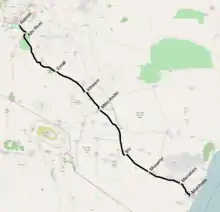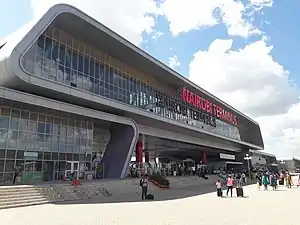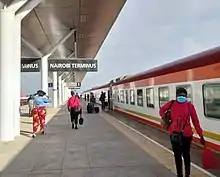Mombasa–Nairobi Standard Gauge Railway
The Mombasa–Nairobi Standard Gauge Railway is a standard-gauge railway (SGR) in Kenya that connects the large Indian Ocean city of Mombasa with Nairobi, the country's capital and largest city. This SGR runs parallel to the narrow-gauge Uganda Railway that was completed in 1901[3] under British colonial rule. The East African Railway Master Plan provides for the Mombasa–Nairobi SGR to link with other SGRs being built in the East African Community.[4]
| Mombasa–Nairobi Standard Gauge Railway | |||||||||||||||||||||||||||||||||||||||||||||||||||||||||||||||||||||||||||||||||||||||||||||||||||||||||||||||
|---|---|---|---|---|---|---|---|---|---|---|---|---|---|---|---|---|---|---|---|---|---|---|---|---|---|---|---|---|---|---|---|---|---|---|---|---|---|---|---|---|---|---|---|---|---|---|---|---|---|---|---|---|---|---|---|---|---|---|---|---|---|---|---|---|---|---|---|---|---|---|---|---|---|---|---|---|---|---|---|---|---|---|---|---|---|---|---|---|---|---|---|---|---|---|---|---|---|---|---|---|---|---|---|---|---|---|---|---|---|---|---|
| Overview | |||||||||||||||||||||||||||||||||||||||||||||||||||||||||||||||||||||||||||||||||||||||||||||||||||||||||||||||
| Status | Operational | ||||||||||||||||||||||||||||||||||||||||||||||||||||||||||||||||||||||||||||||||||||||||||||||||||||||||||||||
| Termini | |||||||||||||||||||||||||||||||||||||||||||||||||||||||||||||||||||||||||||||||||||||||||||||||||||||||||||||||
| Website | www.krc.co.ke | ||||||||||||||||||||||||||||||||||||||||||||||||||||||||||||||||||||||||||||||||||||||||||||||||||||||||||||||
| Service | |||||||||||||||||||||||||||||||||||||||||||||||||||||||||||||||||||||||||||||||||||||||||||||||||||||||||||||||
| Type | Heavy rail | ||||||||||||||||||||||||||||||||||||||||||||||||||||||||||||||||||||||||||||||||||||||||||||||||||||||||||||||
| Ridership | 1,665,627 (2018) | ||||||||||||||||||||||||||||||||||||||||||||||||||||||||||||||||||||||||||||||||||||||||||||||||||||||||||||||
| History | |||||||||||||||||||||||||||||||||||||||||||||||||||||||||||||||||||||||||||||||||||||||||||||||||||||||||||||||
| Opened | 31 May 2017 | ||||||||||||||||||||||||||||||||||||||||||||||||||||||||||||||||||||||||||||||||||||||||||||||||||||||||||||||
| Technical | |||||||||||||||||||||||||||||||||||||||||||||||||||||||||||||||||||||||||||||||||||||||||||||||||||||||||||||||
| Line length | 578.8 km (359.6 mi) | ||||||||||||||||||||||||||||||||||||||||||||||||||||||||||||||||||||||||||||||||||||||||||||||||||||||||||||||
| Character | Fully grade-separated | ||||||||||||||||||||||||||||||||||||||||||||||||||||||||||||||||||||||||||||||||||||||||||||||||||||||||||||||
| Track gauge | 1,435 mm (4 ft 8+1⁄2 in) standard gauge | ||||||||||||||||||||||||||||||||||||||||||||||||||||||||||||||||||||||||||||||||||||||||||||||||||||||||||||||
| Electrification | None, upgrade planned[1][2] | ||||||||||||||||||||||||||||||||||||||||||||||||||||||||||||||||||||||||||||||||||||||||||||||||||||||||||||||
| Operating speed | 120 kilometres per hour (75 mph) (passenger) 80 kilometres per hour (50 mph) (freight) | ||||||||||||||||||||||||||||||||||||||||||||||||||||||||||||||||||||||||||||||||||||||||||||||||||||||||||||||
| |||||||||||||||||||||||||||||||||||||||||||||||||||||||||||||||||||||||||||||||||||||||||||||||||||||||||||||||
At a cost of US$3.6 billion, the SGR was among Kenya's most expensive infrastructure projects as at the time it was launched. The prime contractor was the China Road & Bridge Corporation CRBC, which hired 25,000 Kenyans to work on the railway. CRBC's holding company, China Communications Construction Company is contracted to operate the line for its first five years.[5] As of 2020, railway operation expenses exceeded revenues.[6]
An extension from Nairobi to Suswa was completed in October 2019 extending the line's length to approximately 578.8 kilometres (359.6 mi).
The first fare-paying passengers boarded the "Madaraka Express" on Madaraka Day (1 June 2017), the 54th anniversary of Kenya's attainment of self-rule from Great Britain. Commercial freight services began on 1 January 2018.[7] Passenger uptake has exceeded expectations,[8] with the train carrying 2 million riders in the first 17 months of operation.[9] By November 2018, the SGR was operating 30 freight trains and 4 passenger trains per day.[10] double stack freight trains have run on the line since 2018.[11]
Route

The Mombasa-Nairobi SGR generally runs parallel to the Uganda Railway, a metre-gauge that was built during British colonial rule.[12] The SGR, however, has a straighter alignment that accommodates higher speeds. Because of the rough and hilly terrain, large portions of the SGR were built on viaducts and embankments and in cuttings.
For example, the Uganda Railway tackled the hilly terrain near Mazeras township by using a spiral. In contrast, the SGR passes through this area on two bridges, with the 43.5 metres (142 ft 9 in) high Mazeras-2 bridge being the highest one on the route. As it approaches Nairobi, the SGR crosses the 2.6 kilometres (1.6 mi) Athi River Super Bridge, which at the time of its completion was the sixth-longest bridge in Africa. The SGR has a total of 98 bridges.[13]
Another purpose of the SGR's viaducts and embankments is environmental protection. The SGR passes through the transportation corridor between Tsavo East National Park and Tsavo West National Park, which is also host to the Nairobi–Mombasa Road and the Uganda Railway. Because the road and metre-gauge railway were built at ground level, collisions with wildlife can occur.[14] Viaducts and embankments elevate the SGR above ground level, with underpasses allowing wildlife to pass safely underneath.[14][15]
Passenger trains run between Mombasa Terminus in Miritini and Nairobi Terminus in Syokimau, near the Jomo Kenyatta International Airport.[16]
Freight services are provided between Port Reitz, just west of Mombasa Island, and the inland container depot in the Embakasi division of Nairobi.[17]
Passenger stations

There are nine passenger stations between Mombasa and Nairobi. Each station's architecture is inspired by local elements.[18]
| Station | Architecture |
|---|---|
| Mombasa Terminus | Concentric circles and a central tower, representing a ripple in the ocean. |
| Mariakani | Porticos are inspired by coconut trees, which are plentiful in the region. |
| Miasenyi | White and brown stripes, inspired by the stripes of a zebra. |
| Voi | V-shaped like a person with raised hands, representing the spirit of Harambee. V is also the first letter of Voi. |
| Mtito Andei | Sloping roofs, representing Mount Kilimanjaro and the Chyulu Hills. |
| Kibwezi | Based on traditional African architecture, with leaves that shade passengers from the sun. |
| Emali | A closed fist, representing unity. |
| Athi River | Shaped like the region's hills. |
| Nairobi Terminus | Two trains with a bridge on top. |
Passengers can transfer at Nairobi Terminus to metre-gauge trains into the Nairobi city centre.[16] Although they are designated as terminals, the Mombasa and Nairobi stations were built as through stations and were originally designated Mombasa West Station and Nairobi South Station.[17] When Phase 2 of the SGR is completed, trains will continue through the Nairobi station to the Uganda border.
Specifications
Kenya is a member of the Northern Corridor Integration Project (NCIP), which has selected the Chinese National Railway Class 1 standard for its railways. The adoption of a common standard allows for seamless integration between the railways of NCIP countries.[19]
- Gauge: Standard-gauge
- Couplers: Janney AAR
- Brakes: Air
- Electrification: None, in planning
- Design capacity: 22 million tonnes per year[17]
- Structure gauge: Sufficient for double-stack containers[20]
History


In the 2000s, Kenya's colonial-era metre-gauge railways deteriorated from lack of maintenance. By 2016, passenger trains were taking an entire day to travel from Nairobi to Mombasa, compared to 12 hours during the early 1990s.[12] Freight transported from the Port of Mombasa fell from 4.8 million tonnes per year in the 1980s to 1.5 million tonnes per year in 2012.[21] In 2014, the Rift Valley Railways Consortium, the operator of railways in Kenya and Uganda, reported a loss of US$1.5 million.[22]
At the same time, the Chinese government was funding railway construction in other African countries. In 2011, Kenya signed a memorandum of understanding with the China Road & Bridge Corporation to build a standard-gauge railway between Mombasa and Nairobi. The US$3.6 billion railway was the largest infrastructure project in Kenya since independence.[23] Financing was finalised in May 2014, with the Exim Bank of China extending a loan for 90 percent of the project cost and the remaining 10 percent coming from the Kenyan government.[24][25] 25,000 Kenyans were hired to work on the project.[26]
Tracklaying was completed in December 2016. Passenger service was officially inaugurated on 31 May 2017, eighteen months ahead of schedule.[27]
| Type | Manufacturer | Number | Notes | Source |
|---|---|---|---|---|
| DF8B | CRRC Qishuyan | 8 | Freight locomotive | [28] |
| DF7G | CRRC Qishuyan | 2 | Shunting locomotive /Road switcher | [29][30] |
| DF11 | CRRC Qishuyan | 5 | Passenger locomotive | [30] |
| 25G | CRRC Nanjing Puzhen | 39 | Passenger coaches and support cars | [31] |
| C70E | CRRC Qiqihar | 180 | Gondola | [31] |
| NX70 | CRRC Qiqihar | 150 | Container car | [31] |
Financing
The project cost of the first phase of the SGR from Mombasa to Nairobi was 90% financed by the Export-Import Bank of China. The remainder of the project cost was funded by the Kenyan government. The $3.23 billion financing from Exim was finalised in May 2014. Exim advanced the loan amount in two subsidized loans of US$1.63 billion each. One of the loans was a foreign aid loan provided on a concessional basis (very low interest rate) while the other was a below-market rate preferential export buyer's credit.[32] A condition imposed by the Kenyan government for the financing was 40% of the total project costs or about 130 billion Kenyan shillings would be spent on local supplies including sand, cement, electric cables, galvanised iron and steel.[33]
A condition by Exim Bank for the loan was to have an operator acceptable to the bank for the initial phase of operations, which led the Kenyan government to reject a planned international tender and to contract the mother company of CRBC.[34]
In January 2020, Business Daily Africa reported that the second loan, related to the Nairobi-Naivasha section of the Kenyan SGR, amounting to $1.482 billion, with a five-year grace period, fell due in January 2021. It attracts an interest rate of approximately 3.34 percent per annum and will be due in 30 semi-annual installments, beginning on 21 January 2021 until 21 July 2035.[35]
Land allocation controversy
On July 22, 2020, Mohammed Abdalla Swazuri, the chairman of National Land Commission, and Atanas Kariuki Maina, managing director of the Kenya Railways Corporation, were among 18 officials, businesspeople and companies arrested on corruption charges involving land allocation for the $3 billion flagship Nairobi-Mombasa railway.[36]
Operation
The railway is owned by the Kenya Railways Corporation (KRC), a state-owned corporation of Kenya. It contracts the operations and maintenance of the line to the Africa Star Railway Operations Company (Afristar), a subsidiary of the China Road and Bridge Corporation (CRBC), and the primary constructor of the line. Afristar was given the legal right to the first ten years of operation of the SGR, with an interim review set for the end of the fifth year of the contract.[37][38] While many of the employees working on the SGR are Kenyans, as of July 2018 Chinese workers still occupied most of the critical positions, including dispatchers and locomotive drivers. This sparked political controversy in Kenya, as after one year of operations a full handover to Kenyans was yet to take place.[39][40] The Kenya Transport Ministry explained that a full handover would occur in 2027, according to the current agreement;[41] later, the interim review was initiated to study the feasibility of transferring critical positions to the Kenya Railways Corporation, which successfully negotiated takeover shifting towards an earlier date of May, 2022 with the CRBC.[37] Kenyans will gradually take over all positions on the SGR, completing the full takeover in 2022. During the transition period in June, 2021, the Kenya Railroad Company had already taken over the ticketing, security, and refuelling departments.[42]
In 2018, the railway handled 1.6 million passengers and 5 million tonnes of freight.[43] In 2019, the government required all cargo being cleared in the port in Mombasa to be handled by the railway, leading to protests from cargo transporters.[44] According to a contract between the Exim bank, Kenya Railways Corporation, and Kenya Ports Authority, the KPA must provide 1 million tonnes of freight at the start of the operation, rising to 6 million by 2024.[45]
See also
References
- "Chinese firm lends Kenya Sh25bn to electrify SGR". 27 December 2020.
- "Mombasa-Nairobi electrification contract signed". 8 February 2018.
- R. T. Ogonda (1992). "Transport and Communications in the Colonial Economy". In W. R. Ochieng; R. M. Maxon (eds.). An Economic History of Kenya. Nairobi: East African Educational Publishers. p. 131. ISBN 978-9966-46-963-2.
- China Railway to Link Kenya, Uganda, Rwanda, Burundi and South Sudan
- Sh10.1bn SGR revenues revealed, Daily Nation Kenya 7 December 2019
- Ian Gorecki (24 September 2020). "Kenya's Standard Gauge Railway: The Promise and Risks of Rail Megaprojects". Africa Up Close. Woodrow Wilson International Center for Scholars. Retrieved 16 October 2022.
While revenues are up, the system is still running at a loss
- "Mombasa – Nairobi standard gauge freight service launched". Railway Gazette International. 3 January 2018. Retrieved 19 February 2019.
- Erick Kombo Ndubi (5 November 2018). "VIP treatment for loyal nurse as Madaraka Express hits 2 million passenger mark". Tuko. Retrieved 19 February 2019.
- Moses Omusula (3 November 2018). "SGR train clocks 2 million passengers". The Standard. Nairobi. Retrieved 19 February 2019.
- Sanga, Benard (26 November 2018). "SGR set to transport 8 million tonnes of cargo". The Standard.
- "SGR launch double-stack freight trains to boost efficiency at Mombasa Port".
- Daniel Knowles (July–August 2016). "Journeys: The lunatic express". 1843 Magazine. The Economist.
- Simon Ciuri. "Breathtaking and hair-raising scenery of Kenya's Standard Gauge Railway (photos)". tuko.co.ke. Retrieved 23 January 2017.
- Buffalo, Built by (24 May 2015). "Bull Elephants Killed By Train". Sheldrick Wildlife Trust.
The Mombasa-Nairobi transport corridor divides East and West Tsavo, and wildlife, including Tsavo's elephant populations, frequently have to cross both the busy road and railway as they move from one area to another. Already this year at least 7 elephants have lost their lives in Tsavo alone due to accidents on the road and railway. ... The new railway will be raised off the ground by 4 metres and punctuated by tunnels for wildlife to pass through, so hopefully its construction will reduce the number of fatalities.
- Gilbert Koech (29 December 2016). "Jumbos using underpasses in Tsavo". The Star.
- Sandra Chao-Blasto; Kiarie Njoroge (13 January 2016). "Mombasa SGR passengers to change trains at Syokimau".
- "Mombasa-Nairobi Standard Gauge Railway Project". Railway Technology. Retrieved 4 December 2016.
- Peter Muiruri (3 April 2017). "Inspiration behind Standard Gauge Railway stations". The Standard.
- "Information about Standard Gauge Railway" (PDF). Uganda Ministry of Works, Transportation and Communication. 7 April 2017.
Date found at introductory page: http://www.newvision.co.ug/new_vision/news/1450522/information-about-standard-gauge-railway
{{cite web}}: External link in|quote= - "Salient features of the standard gauge railway". Kenya Railways Corporation. Retrieved 22 July 2018.
- David Mugwe (19 August 2013). "Rail transport makes a comeback". Daily Nation. Nairobi. Retrieved 22 July 2018.
- Patrick Mayoyo; Berber Verpoest; George Turner (22 June 2016). "World Bank looks into case of 'Embezzlement' at RVR". The Observer. Kampala, Uganda. Retrieved 22 July 2018.
- Inside the SGR, Kenya's largest and most expensive infrastructure project since Independence. NTV Kenya.
- "Mombasa - Nairobi standard gauge line funding agreed". Railway Gazette International. 14 May 2014. Retrieved 22 July 2018.
- "Kenya, China sign standard gauge railway agreement". Daily Nation. 11 May 2014.
- Hou Liqiang (20 September 2015). "Chinese company helps build new railway in Kenya". China Daily. Archived from the original on 7 October 2015.
- "Kenya opens Nairobi-Mombasa Madaraka Express railway". BBC News. 31 May 2017. Retrieved 31 May 2017.
- "SGR Photo Updates". megaprojects.co.ke. Archived from the original on 23 June 2016. Retrieved 21 May 2016.
- "DF7G diesel shunting locomotive" (in Chinese (China)). CRRC Qishuyan.
- "Kenyan standard gauge locomotives unveiled". Railway Gazette International. 20 December 2016.
- "蒙内铁路项目第五、六批轨道设备顺利登港" (in Chinese). 中国路桥工程有限公司. 20 March 2017. Archived from the original on 21 April 2017. Retrieved 20 April 2017.
- "Truckers lose out under railway financing deal with China". Business Daily. 24 February 2014.
- "China rail contractor to buy Sh130bn local materials". Business Daily. 16 June 2014.
- Why Chinese Bank Imposed SGR Line Operator on Kenya, by Kiarie Njoroge in Business Daily, 18 May 2016, 6
- Otiato Guguyu (5 January 2021). "Debt pain as payment of Sh162bn Naivasha SGR loan starts". Business Daily Africa. Nairobi. Retrieved 5 January 2021.
- Mahlo, Humphrey (11 August 2018). "Kenya arrests two top officials for suspected corruption over new $3 billion railway". Reuters. Archived from the original on 3 January 2021. Retrieved 9 December 2020.
- "Kenya Railways to end SGR contract with Afristar". International Railway Journal. 12 March 2021.
- OTIENO, BONFACE (5 March 2021). "Kenya Railways starts SGR takeover from Chinese firm". businessdailyafrica.
- Paul Wafula (7 July 2018). "Exclusive: Behind the SGR walls". Standard Digital. Nairobi. Retrieved 23 July 2018.
- Patrick Vidija (11 July 2018). "Senate summons Kenya Railways, labour CS over alleged mistreatment of SGR employees". The Star. Nairobi. Retrieved 23 July 2018.
- Lang'at, Patrick (18 July 2018). "Chinese to work at Kenya's Standard Gauge Railway till 2027". Daily Nation.
- "Kenya Railways begins the SGR takeover". kenyanwallstreet. 5 March 2021.
- Kenya National Bureau of Statistics (10 April 2019). "Leading Economic Indicators January 2019: Passenger and Cargo Movement on the Standard Gauge Railway". Nairobi. Retrieved 16 April 2019.
- "Kenya forcing importers to use costly new Chinese railway, businessmen say". Reuters. 3 December 2019. Retrieved 3 December 2019.
- "Kenya forcing importers to use costly new Chinese railway, businessmen say". Reuters. 3 December 2019. Retrieved 8 February 2020.